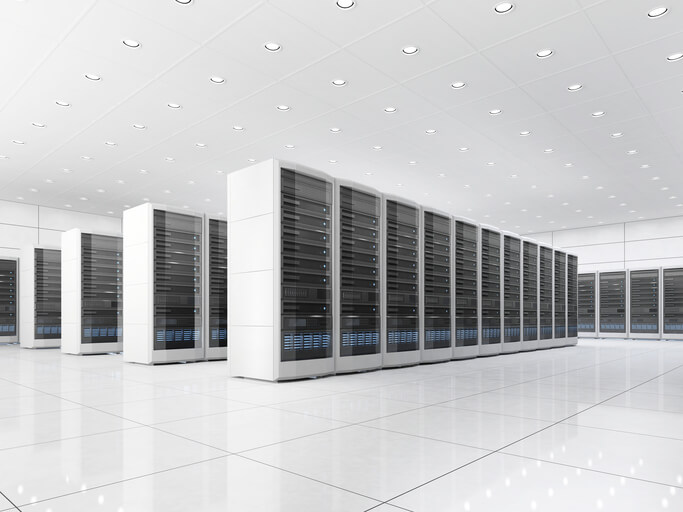In 2014, US data centers constituted 1.8% of total US power consumption, and this number is only expected to rise in the coming years. Now, for many, 1.8% may seem low, but building designers know power consumption can easily skyrocket as more and more data centers are built, so they continue to look for ways to optimize data center energy use.
In recent years, the search for better solutions has led to the introduction of airside economizers. Airside economizers bring external air into the building and distribute it throughout the facility. Also, they mix cold air with exhaust air to maintain the temperature and humidity within the accepted range. While the implementation of airside economizers may not be mainstream, clearly they are a viable solution for improving data center energy efficiency.
Problems with Traditional Cooling Systems
Traditional data center cooling systems, also known as precision cooling, are dependent on almost 100% recirculation of air. Only a minimum quantity of outdoor air is introduced into the system. This method is problematic because it leads to high energy consumption. The cooling system by itself needs almost as much energy as the servers (a 2:1 ratio of total power to computer power). While this traditional cooling method isn’t sustainable long-term, it’s currently considered the norm and needs to change.
Lowering PUE
The Power Utilization Efficiency (PUE) metric was first defined by a conglomerate of industry stakeholders called The Green Grid in 2007. The metric quickly gained popularity in the data center industry. Data center designers started to pay attention to PUE as a useful metric and adopted it for their own data centers. Using economizers, including airside economizers, became one of the primary techniques for improving data center PUE ratings. The expansion of the ASHRAE Thermal Guidelines further helped make economizers a standard for using within data center cooling systems.
Airside Economizers: Overview
Airside economizers can perform direct exchange where outdoor air is directly introduced to the data center facility. Or indirect exchange where air-to-air heat exchange ensures that outdoor and indoor air stays isolated.
Airside economizers can be integrated or nonintegrated. In the integrated type, the compressor can work while the economizer is running. In the non-integrated type, the compressor shuts off when the airside economizer is operational.
Controls
The economizer function is operated by high-limit control. Some commercially available options are fixed dry-bulb, differential dry-bulb, fixed enthalpy, differential enthalpy, differential enthalpy + fixed dry bulb, differential enthalpy + differential dry bulb, fixed enthalpy + fixed dry bulb, and dew point + fixed dry bulb. Enthalpy is a combination of temperature and humidity.
In dry climates, the economizer can solely rely on the dry-bulb. But for other areas, enthalpy controls should dictate the switchover from the chillers to the airside economizers.
Designers can also add a wet-bulb or adiabatic cooler to airside economizers to create adiabatic economizers. This design adds humidity to the air through spraying, which can be useful in desert areas.
Considerations
Here are some considerations particular to airside economizers:
- Geographic area: Economizers are better suited for cooler climate zones. Designers will get the best energy savings with airside economizers working with direct exchange of outdoor air.
- Thermal conditions: If data center designers are willing to accept higher inlet temperatures and broader humidity conditions, then there are more opportunities for energy savings. Under that circumstance, it’s even possible to eliminate chillers from data centers.
- Airborne and Gaseous Contamination: The introduction of outside air is a potential risk depending on the electronics manufacturing in the data center. Oftentimes, outside contaminants can have a long-term effect on equipment, making it more prone to corrosion and premature systems failure.
- Economizer Economics: Load variations, environmental, and redundancy needs contribute to the initial capital costs, which at first may present sticker shock. However, due to the need for continuous and high loads in a date center, there is great potential for long-term cost savings.
Standardization
ASHRAE Standard 90.1 was amended to include data centers. But the standard also provides some exception for economizer use. The industry wanted a new ASHRAE standard specific to the data centers. In 2012, ASHRAE approved a committee to create Standard 90.4 Energy Standards for Data Centers and Telecommunications. The standard will take a performance-based approach with emphasis on the following:
- Options available in the industry
- Changes and innovations in the industry
- Risk considerations for various data center applications
- Finding an industry rating standard on performance of economizers
The need for economizers in data centers
While it may be obvious, data centers require different cooling needs than any other business. For example, data centers require higher internal load conditions than commercial buildings, and they need multiple control variables for temperature, pressure, and humidity. Variables like temperature and humidity have rigid rules and regulations, so it’s not just any off-the-shelf solution that will work for data centers.
Studies have shown that airside economizers can optimize data center performance, and most importantly, have huge potential for improving energy efficiency and PUE. They have many benefits, including maintaining the temperature and humidity within an accepted range. However, selecting an economizer is no easy task. Because of the multiple options available and the level of considerations when selecting an economizer, it is always recommended to consult with HVAC professionals to offer the best solution. Professionals will help assess the needs of the data center, consider the factors addressed above, and recommend a compatible system for optimal performance and long-term savings.
Contact Air2O and learn more about the best cooling solution for your data center.
References:
-
Airside Economizers in Data Centers pdf on ASHRAE
-
EnergyStar
-
US Data Center Energy
-
Data Aire – Air Side Economizer


